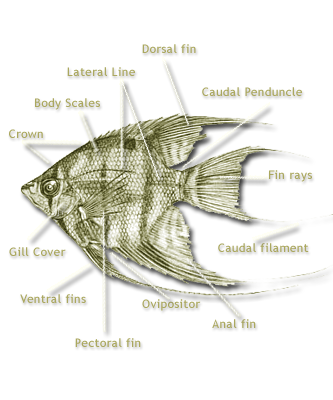 |
Anal fin: Single fin mounted vertically below the fish.
Anterior: The head end of an animal. When used as a direction
refers to "in front of" as in "the eye is anterior of the anal
fin."
Barbel: Whisker-like growths around the mouth, used for
finding food and communication; a sensory organ.
Caudal fin: Single fin at the back of a fish-the tail fin.
Refers only to the actual fin rather than the whole of the
posterior end of the fish.
Caudal Peduncle: A section of the body between the vent and
the caudal fin. Supports the caudal fin.
Dorsal fin: The single fin along the back of a fish,
between the head and caudal fin. Some other kinds of
fishes have two dorsal fins, some have a dorsal fin
and an adipose fin.
Genital Papillae: Little nipple-like structures which
are often referred to as ovipositors, a word which
literally means "egg-placer(s)."
Gill cover: A hard bony plate covering the gills.
Eye: Sight organ. One on each side of the head in Poeciliids.
Gill slit: The opening at the posterior end of the operculum
allowing water to flow out of the mouth, past the gills, for breathing.
Gular region: The area immediately under the mouth, in front of
the throat. In humans, this is the bit between your chin and your neck.
Head: The area of the fish in front of the gill slit.
Lateral: The side of an animal. When used as a direction means
"to the side of," as in "the eyes are lateral to the brain."
Lateral line: A line of sensory scales along the sides of fish
that enables them to detect vibrations and electrical impulses
from other fish. Used for sensing motion in the water, it is
extremely sensitive, and can even feel sound waves pushing on
the water.
Mouth: The opening into which food and water are taken. Located in the head.
Operculum: Bony plate covering the gill cavity in the head
of a fish. Gill slit runs along the posterior edge of the operculum.
Pectoral fin: One of the most anterior paired set of fins, in
most livebearers located laterally immediately posterior to the
gill slit, on the side of the body. Used for fine movement backward and forward.
Pelvic fin: One of the most posterior paired set of fins, in most
livebearers located ventrally, just anterior to the anal fin.
Used for stability in the water (helps keep the fish from rolling).
Posterior: The tail end. When used as a direction, refers to
"toward the tail," as in "the caudal fin is posterior to the anal fin."
Pupil: The dark portion of the eye through which light enters.
Ray: A branched, relatively soft fin support structure,
located in any fin, but posterior to any spines in that fin.
Snout: The area of a fishes head anterior to the eye.
Spine: An unbranched, relatively stiff fin support structure,
may be located in any fin, but anterior to any rays in that fin.
Standard length: The distance from the anterior tip of the
snout to the base of the tail. Not including the caudal fin.
Tail extension: Elongated part of the tail, seen in species with
"swords" and in lyretail forms.
Total Length: The distance from the anterior tip of the snout
to the posterior edge of the tail. In species with a tail
extension (such as swordtails) total length is measured without
the tail extension, with the tail extension measurement given as well.
Vent: The opening of the digestive and reproductive tracts,
located just posterior to the anal fin.
Ventral: The side of a fish opposite the dorsal side,
usually facing toward the bottom of the tank. |